Examining the Barriers to Redesigning Smallholder Production Practices for Water-Use Efficiency in Numbi, Mbombela Local Municipality, South Africa
Abstract
1. Introduction
2. Materials and Methods
2.1. Study Site
2.2. Study Design
2.3. Sampling Method and Sample Size
2.4. Data Collection
2.5. Data Analysis
3. Results
3.1. Socioeconomic Factors of Smallholder Farmers in Numbi
3.2. Distribution of Barriers in Redesigning Production Practices
3.3. The Correlation of Primary Irrigation Water Source and the Applicarion of WUE Approaches
4. Discussion
4.1. Socioeconomic Factors of Smallholder Farmers in the Study Area
4.2. Barriers in Redesigning Production Practices for Water-Use Efficiency
4.3. The Correlation of Primary Irrigation Water Sources and the Applicarion of WUE Approaches
4.4. Study Summary
4.5. Study Limitations
5. Conclusions
- Enhancing access to affordable credit and financial instruments is essential, enabling farmers to invest in advanced irrigation systems and water storage infrastructure.
- Improving farmer education and capacity-building initiatives, particularly in irrigation management, is critical. These programs should target older and less educated farmers to facilitate the adoption of more sophisticated WUE practices.
- Policy efforts must also prioritize investment in water infrastructure, ensuring equitable access to reliable water sources and promoting the implementation of efficient irrigation technologies, such as drip or micro-irrigation systems.
- Policies should promote climate-resilient agricultural practices, including the cultivation of drought-tolerant crops and the adoption of soil water retention techniques, to help farmers adapt to the challenges posed by climate variability.
- To reduce financial instability, improving market access and stability through the strengthening of local agricultural markets and farmer cooperatives is necessary, as this would encourage greater investment in sustainable WUE practices.
- In conclusion, gender-sensitive policy interventions that provide targeted support to female farmers are imperative to ensure equitable resource allocation and empowerment.
Author Contributions
Funding
Data Availability Statement
Acknowledgments
Conflicts of Interest
References
- Rosa, L.; Chiarelli, D.D.; Rulli, M.C.; Dell ‘Angelo, J.; D’Odorico, P. Global agricultural economic water scarcity. Sci. Adv. 2020, 6, eaaz6031. [Google Scholar] [CrossRef] [PubMed]
- Agholor, A.I.; Nkosi, M. Sustainable water conservation practices and challenges among smallholder farmers in Enyibe Ermelo Mpumalanga Province, South Africa. J. Agric. Ext. 2020, 24, 112–123. [Google Scholar] [CrossRef]
- Ogundeji, A.A. Adaptation to climate change and impact on smallholder farmers’ food security in South Africa. Agriculture 2022, 12, 589. [Google Scholar] [CrossRef]
- Mbuli, C.S.; Fonjong, L.N.; Fletcher, A.J. Climate change and small farmers’ vulnerability to food insecurity in Cameroon. Sustainability 2021, 13, 1523. [Google Scholar] [CrossRef]
- Rapholo, M.T.; Diko Makia, L. Are smallholder farmers’ perceptions of climate variability supported by climatological evidence? Case study of a semi-arid region in South Africa. Int. J. Clim. Chang. Strat. Manag. 2020, 12, 571–585. [Google Scholar] [CrossRef]
- Matos, S.; Viardot, E.; Sovacool, B.K.; Geels, F.W.; Xiong, Y. Innovation and climate change: A review and introduction to the special issue. Technovation 2022, 117, 102612. [Google Scholar] [CrossRef]
- Haileslassie, A.; Agide, Z.; Erkossa, T.; Hoekstra, D.; Schmitter, P.S.; Langan, S.J. On-Farm Smallholder Irrigation Performance in Ethiopia: From Water Use Efficiency to Equity and Sustainability; International Livestock Research Institute: Nairobi, Kenya, 2016; pp. 1–33. [Google Scholar]
- Morepje, M.T. Redesigning Production Systems for Water-Use Efficiency Amongst Smallholder Farmers at Numbi, South Africa. Master’s Thesis, University of Mpumalanga, Mbombela, South Africa, 2024. Available online: https://openscholar.ump.ac.za/handle/20.500.12714/803 (accessed on 21 September 2024).
- Mohammedshum, A.A.; Mannaerts, C.M.; Maathuis, B.H.; Teka, D. Integrating socioeconomic biophysical and institutional factors for evaluating small-scale irrigation schemes in Northern Ethiopia. Sustainability 2023, 15, 1704. [Google Scholar] [CrossRef]
- Antwi-Agyei, P.; Stringer, L.C. Improving the effectiveness of agricultural extension services in supporting farmers to adapt to climate change: Insights from northeastern Ghana. Clim. Risk Manag. 2021, 32, 100304. [Google Scholar] [CrossRef]
- Nhamo, L. Chapter 8—Advances in water research: Enhancing sustainable water use in irrigated agriculture in South Africa. Sustain. Dev. 2023, 19, 233–248. [Google Scholar] [CrossRef]
- Branca, G.; Cacchiarelli, L.; Haug, R.; Sorrentino, A. Promoting sustainable change of smallholders’ agriculture in Africa: Policy and institutional implications from a socio-economic cross-country comparative analysis. J. Clean. Prod. 2022, 11, 478. [Google Scholar] [CrossRef]
- DEA (DWS). National Water and Sanitation Master Plan. Department of Water and Sanitation, South Africa. 2019. Available online: https://www.dws.gov.za/National%20Water%20and%20Sanitation%20Master%20Plan/ (accessed on 16 September 2024).
- Morepje, M.T.; Agholor, I.A.; Sithole, M.Z.; Mgwenya, L.I.; Msweli, N.S.; Thabane, V.N. An Analysis of the Acceptance of Water Management Systems among Smallholder Farmers in Numbi, Mpumalanga Province, South Africa. Sustainability 2024, 16, 1952. [Google Scholar] [CrossRef]
- Kapari, M.; Hlophe-Ginindza, S.; Luxon, N.; Mpandeli, S. Contribution of smallholder farmers to food security and opportunities for resilient farming systems. J. Front. Sustain. Food Syst. 2023, 7, 11. [Google Scholar] [CrossRef]
- Kamara, A.; Abdul, R.; Edward, R.; Richard, C. The relevance of smallholder farming to African Agricultural Growth and Development. Afr. J. Front. 2019, 19, 14043–14065. [Google Scholar] [CrossRef]
- Wakweya, R.B. Challenges and prospects of adopting climate-smart agricultural practices and technologies: Implications for food security. J. Agric. Food Res. 2023, 14, 100698. [Google Scholar] [CrossRef]
- Mwale, M.; Sibuyi, S.K.; Downsborough, L.; Zuwarimwe, J. Developing resilient small-scale farmers against water scarcity in rural-based crop production farms, South Africa. Agriculture 2021, 23, 34–52. [Google Scholar] [CrossRef]
- Alharbi, S.; Abrar, F.; Ahmed, A.; Al-Dakhil, M. Agricultural and Technology-based strategies to improve water-use efficiency in Arid and Semiarid areas. Water 2024, 16, 1842. [Google Scholar] [CrossRef]
- Evans, R.; Sadler, J. Methods and technologies to improve efficiency of water use. J. Water Resour. Res. 2008, 44, 674. [Google Scholar] [CrossRef]
- Ingrao, C.; Rossana, S.; Giovanni, L.; Huisingh, D. Water scarcity in agriculture: An overview of causes, impacts and approaches for reducing the risks. Heliyon 2023, 9, e18507. [Google Scholar] [CrossRef]
- Department of Water Affairs (DWA). National Water Policy of South Africa. Available online: https://www.dws.gov.za/documents/Other/Strategic%20Plan/NWRS2-Final-email-version.pdf (accessed on 12 July 2024).
- Msweli, N.S.; Agholor, I.A.; Sithole, M.Z.; Morepje, M.T.; Thabane, V.N.; Mgwenya, L.; Msweli, N.S. The Determinants and Acceptance of Climate Smart Agriculture Practices in South Africa. Afr. J. Food Agric. Nut. Dev. 2024, 24, 24591–24610. [Google Scholar] [CrossRef]
- Food and Agriculture Organization of the United Nations (FAO). The State of Agricultural Commodity Markets. Rome, Italy. 2022. Available online: https://www.fao.org/publications/home/fao-flagship-publications/the-state-of-agricultural-commodity-markets/en (accessed on 22 October 2024).
- Bouis, H.E.; Saltzman, A. Improving nutrition through bio-fortification: A review of evidence from Harvest-Plus, 2003 through 2016. Glob. Food Sec. 2018, 12, 49–58. [Google Scholar] [CrossRef]
- Nkiaka, E.; Bryant, R.G.; Okumah, M.; Gomo, F.F. Water security in sub-Saharan Africa: Understanding the status of sustainable development goal 6. Wiley Interdiscip. Rev. Water 2021, 8, e1552. [Google Scholar] [CrossRef]
- StatsSA. My Settlement. 2011. Available online: https://www.statssa.gov.za/?page_id=4286&id=11670 (accessed on 6 July 2024).
- Bukhari, S.A. The impact of a global Englishes course on teachers’ attitudes towards teaching English as a global language. Int. J. Engl. Lang. Teach. 2023, 11, 25–42. [Google Scholar] [CrossRef]
- Assan, E.; Suvedi, M.; Olabisi, L.S.; Bansah, K.J. Climate change perceptions and challenges to adaptation among smallholder farmers in semi-arid Ghana: A gender analysis. J. Arid Environ. 2020, 182, 104247. [Google Scholar] [CrossRef]
- Mallareddy, M.; Thirumalaikumar, R.; Balasubramanian, P.; Naseeruddin, R.; Nithya, N.; Mariadoss, A.; Eazhilkrishna, N.; Choudhary, A.K.; Deiveegan, M.; Subramanian, E.; et al. Maximizing water use efficiency in rice farming: A comprehensive review of innovative irrigation management technologies. Water 2023, 15, 1802. [Google Scholar] [CrossRef]
- Alant, B.P.; Bakare, O.O. A case study of the relationship between smallholder farmers’ ICT literacy levels and demographic data wrt their use and adoption of ICT for weather forecasting. Heliyon 2021, 7, e06403. [Google Scholar] [CrossRef]
- Thinda, K.T.; Ogundeji, A.A.; Belle, J.A.; Ojo, T.O. Understanding the adoption of climate change adaptation strategies among smallholder farmers: Evidence from land reform beneficiaries in South Africa. Land Use Policy 2020, 99, 104858. [Google Scholar] [CrossRef]
- Atube, F.; Malinga, G.M.; Nyeko, M.; Okello, D.M.; Alarakol, S.P.; Okello-Uma, I. Determinants of smallholder farmers’ adaptation strategies to the effects of climate change: Evidence from northern Uganda. Agric. Food Secur. 2021, 10, 1–14. [Google Scholar] [CrossRef]
- Sapbamrer, R.; Thammachai, A. A systematic review of factors influencing farmers’ adoption of organic farming. Sustainability 2021, 13, 3842. [Google Scholar] [CrossRef]
- Danso-Abbeam, G.; Dagunga, G.; Ehiakpor, D.S. Rural non-farm income diversification: Implications on smallholder farmers’ welfare and agricultural technology adoption in Ghana. Heliyon 2020, 6, e05393. [Google Scholar] [CrossRef]
- Agbenyo, W.; Jiang, Y.; Jia, X.; Wang, J.; Ntim-Amo, G.; Dunya, R.; Siaw, A.; Asare, I.; Twumasi, M.A. Does the adoption of climate-smart agricultural practices impact farmers’ income? Evidence from Ghana. Int. J. Environ. Res. Public Health 2022, 19, 3804. [Google Scholar] [CrossRef]
- Mwangi, R.M.; Kimemia, G.M.; Kuria, J.M. Effect of irrigation scheduling and rainwater harvesting on maize (Zea mays L.) productivity and soil moisture in semi-arid areas of Kenya. J. Afr. Earth Sci. 2017, 124, 232–243. [Google Scholar]
- Paudel, K.P.; Pandit, M.; Hinson, R. Irrigation water sources and irrigation application methods used by US plant nursery producers. Water Resour. Res. 2016, 52, 698–712. [Google Scholar] [CrossRef]
- Mabuza, M.; Ndoro, J.T. Borich’s needs model analysis of smallholder farmers’ competence in irrigation water management: Case study of Nkomazi local municipality, Mpumalanga province in South Africa. Sustainability 2023, 15, 4935. [Google Scholar] [CrossRef]
- Pili, O.; Ncube, B. Smallholder farmer coping and adaptation strategies for agricultural water use during drought periods in the Overberg and West Coast Districts, Western Cape, South Africa. Water SA 2022, 48, 97–109. [Google Scholar] [CrossRef]
- Abdullah, A.H.; Almasraf, S.A. Assessment Improving of Rainwater Retention on Crop Yield and Crop Water Use Efficiency for Winter Wheat. J. Eng. 2020, 26, 46–54. [Google Scholar] [CrossRef][Green Version]
- Van De Zande, G.D.; Amrose, S.; Donlon, E.; Shamshery, P.; Winter V, A.G. Identifying opportunities for irrigation systems to meet the specific needs of farmers in East Africa. Water 2024, 16, 75. [Google Scholar] [CrossRef]
- Mitku, D.T.; Adamite, T.F.; Tefera, A.H. Verification and Demonstration of Low-Cost and Appropriate Micro-Irrigation System for Crop Production Under Smallholder Farmers Condition in Pawe District of Metekel Zone. Int. J. Adv. Res. Biol. Sci. 2022, 9, 198–206. [Google Scholar]
- Dessale, M. Determinants and food security impacts of small-scale irrigation in Ethiopia. J. Bus. Econ. 2020, 11, 6. [Google Scholar] [CrossRef]
- Mugejo, K.; Ncube, B. Determinants of water security in smallholder farming systems in South Africa: A review. Fundam. Appl. Agric. 2022, 7, 235–249. [Google Scholar] [CrossRef]
- Patel, A.; Kushwaha, N.L.; Rajput, J.; Gautam, P.V. Advances in Micro-Irrigation Practices for Improving Water Use Efficiency in Dryland Agriculture. In Enhancing Resilience of Dryland Agriculture Under Changing Climate: Interdisciplinary and Convergence Approaches; Springer Nature: Singapore, 2023; pp. 157–176. [Google Scholar] [CrossRef]
- Zerssa, G.; Feyssa, D.; Kim, D.G.; Eichler-Löbermann, B. Challenges of smallholder farming in Ethiopia and opportunities by adopting climate-smart agriculture. Agriculture 2021, 11, 192. [Google Scholar] [CrossRef]
- Yu, L.; Gao, X.; Zhao, X. Global synthesis of the impact of droughts on crops’ water-use efficiency (WUE): Towards both high WUE and productivity. Agric. Syst. 2020, 177, 102723. [Google Scholar] [CrossRef]
- Usman, M.A.; Callo-Concha, D. Does market access improve dietary diversity and food security? Evidence from Southwestern Ethiopian smallholder coffee producers. Agric. Food Econ. 2021, 9, 18. [Google Scholar] [CrossRef]
- Balana, B.B.; Oyeyemi, M.A. Agricultural credit constraints in smallholder farming in developing countries: Evidence from Nigeria. World Dev. Sustain. 2022, 1, 100012. [Google Scholar] [CrossRef]
- Liu, Y.; Song, W. Modelling crop yield, water consumption, and water use efficiency for sustainable agroecosystem management. J. Clean. Prod. 2020, 253, 119940. [Google Scholar] [CrossRef]
- Kom, Z.; Nethengwe, N.S.; Mpandeli, N.S.; Chikoore, H. Determinants of small-scale farmers’ choice and adaptive strategies in response to climatic shocks in Vhembe District, South Africa. GeoJournal 2022, 87, 677–700. [Google Scholar] [CrossRef]
- De Witt, M.; De Clercq, W.P.; Velazquez, F.J.B.; Altobelli, F.; Marta, A.D. An in-depth evaluation of personal barriers to technology adoption in irrigated agriculture in South Africa. Outlook Agric. 2021, 50, 259–268. [Google Scholar] [CrossRef]
- Durga, N.; Schmitter, P.; Ringler, C.; Mishra, S.; Magombeyi, M.S.; Ofosu, A.; Pavelic, P.; Hagos, F.; Melaku, D.; Verma, S.; et al. Barriers to the uptake of solar-powered irrigation by smallholder farmers in sub-Saharan Africa: A review. Energy Strat. Rev. 2024, 51, 101294. [Google Scholar] [CrossRef]
- Singh, S. Farmers’ Perception of Climate Change and Adaptation Decisions: A Micro-Level Evidence from Bundelkhand Region, India. Ecol. Indic. 2020, 116, 106475. [Google Scholar] [CrossRef]
- Guo, D.; Olesen, J.E.; Manevski, K.; Ma, X. Optimizing irrigation schedule in a large agricultural region under different hydrologic scenarios. Agric. Water Manag. 2021, 245, 106575. [Google Scholar] [CrossRef]
- Velasco-Muñoz, J.F.; Aznar-Sánchez, J.A.; Batlles-delaFuente, A.; Fidelibus, M.D. Rainwater harvesting for agricultural irrigation: An analysis of global research. Water 2019, 11, 1320. [Google Scholar] [CrossRef]
- Morepje, M.T.; Sithole, M.Z.; Msweli, N.S.; Agholor, A.I. The Influence of E-Commerce Platforms on Sustainable Agriculture Practices among Smallholder Farmers in Sub-Saharan Africa. Sustainability 2024, 16, 6496. [Google Scholar] [CrossRef]
- Sithole, M.Z.; Agholor, I.A.; Msweli, N.S.; Morepje, M.T. Towards Sustainable Agriculture: The Opportunities and Challenges of Artificial Intelligence in Agricultural Advisory Services. Proc. NEMISA Digit. 2024, 6, 1–12. [Google Scholar] [CrossRef]
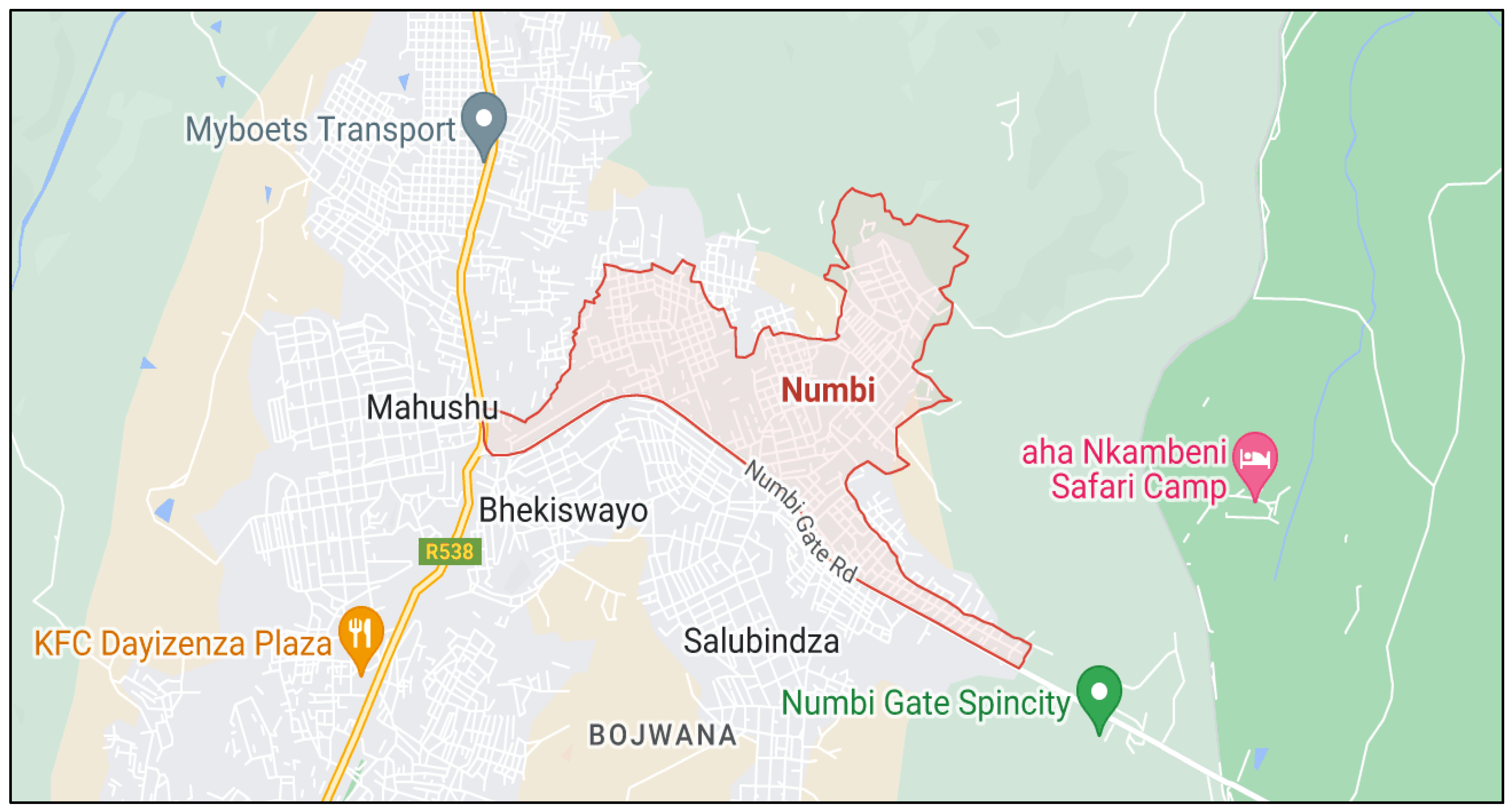
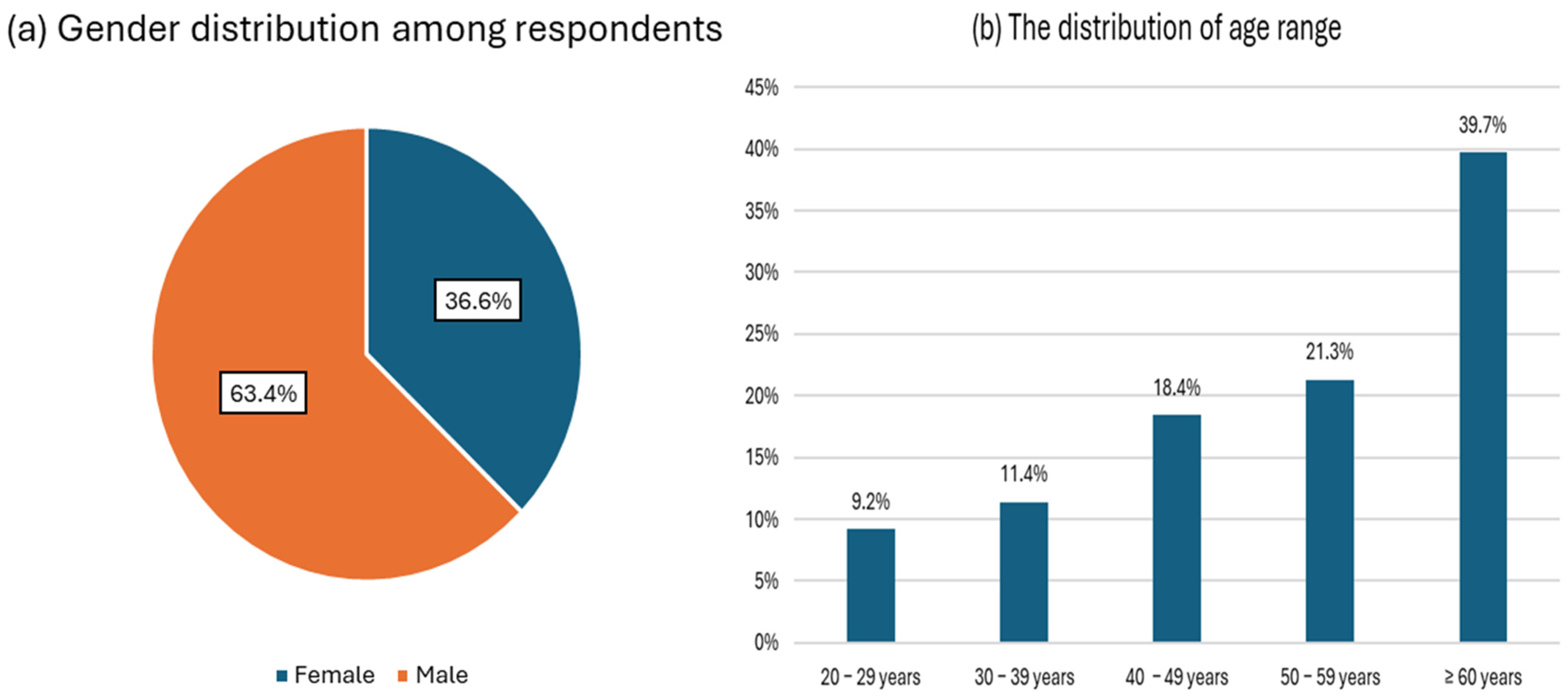
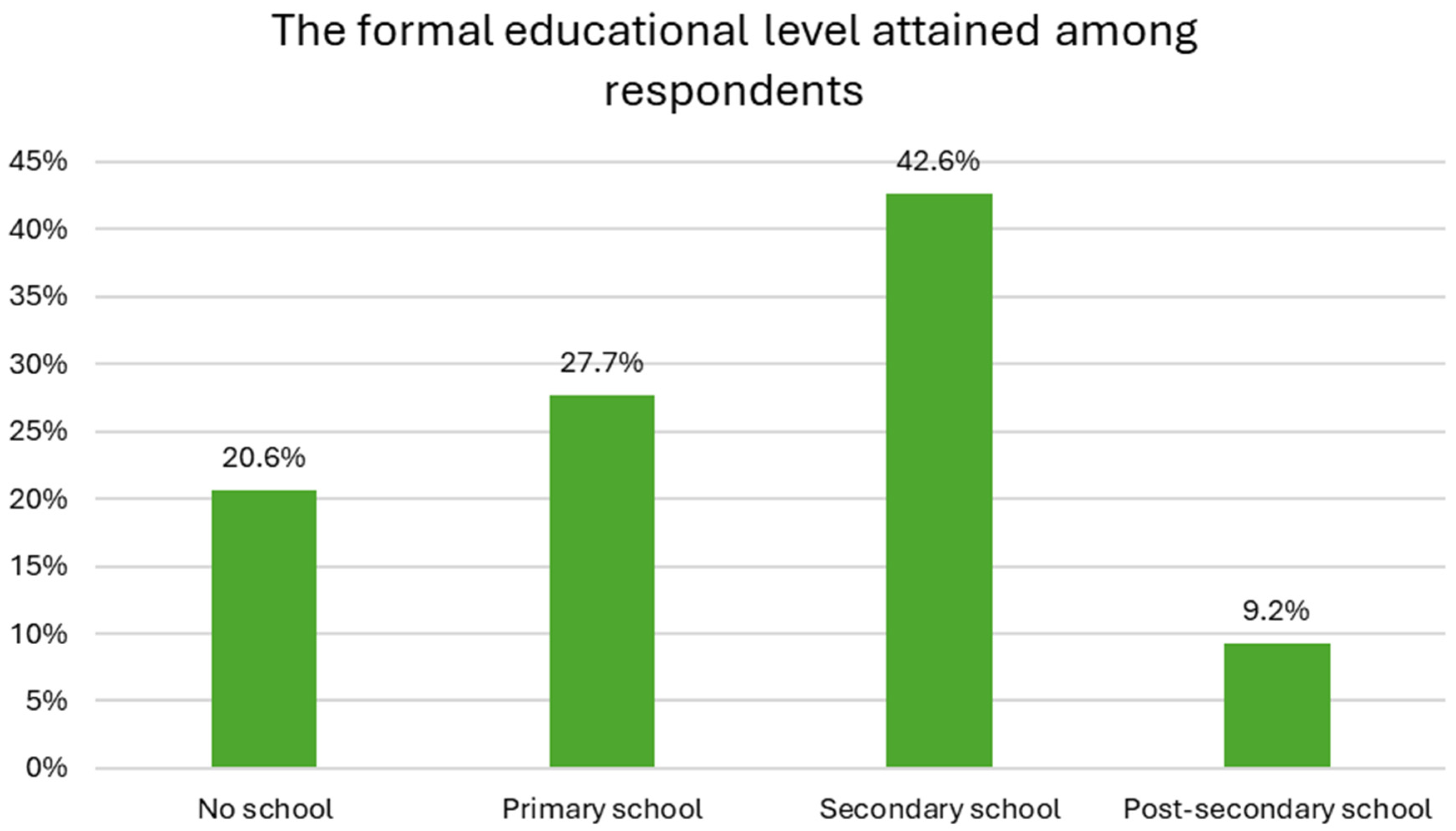
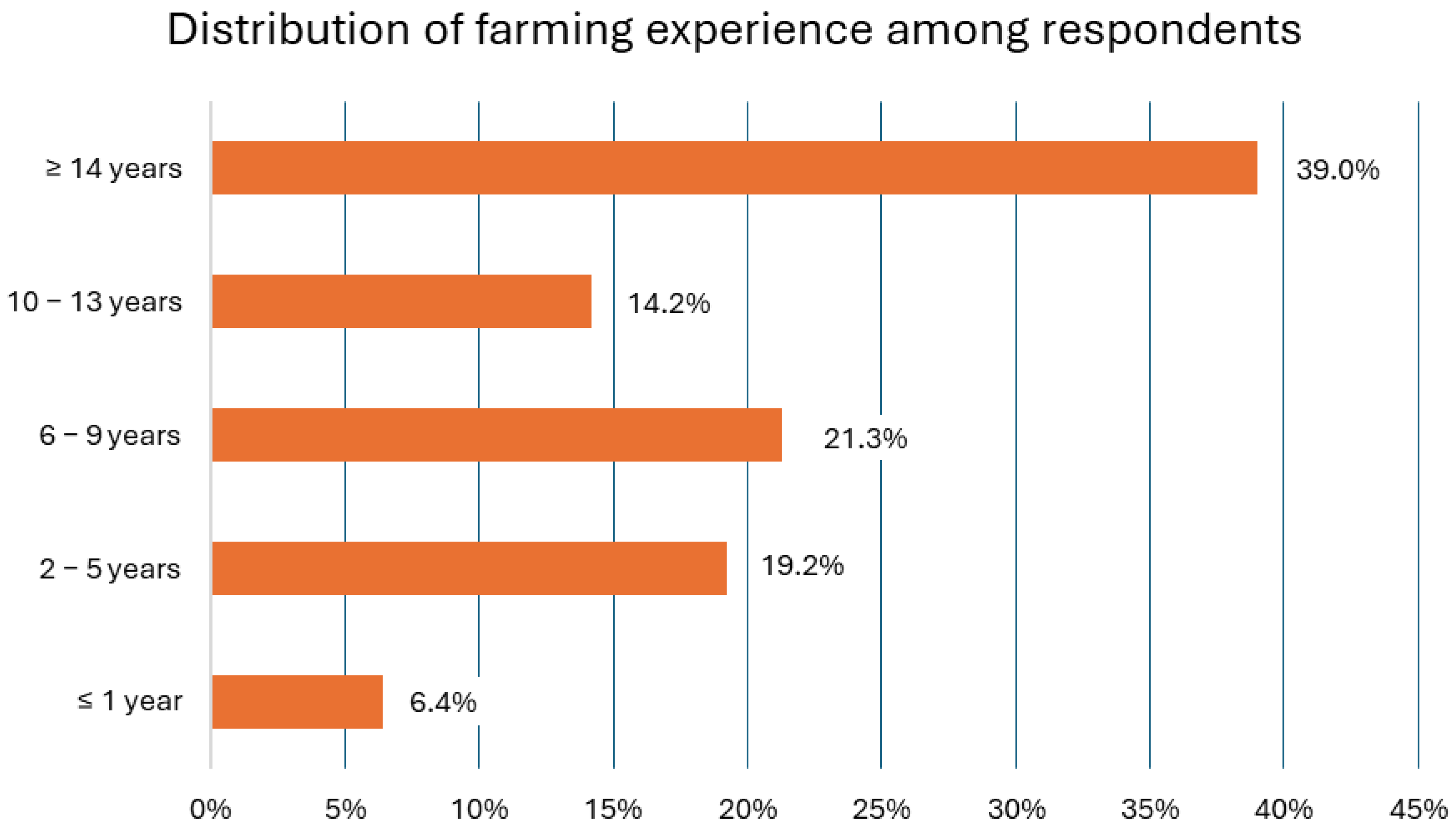
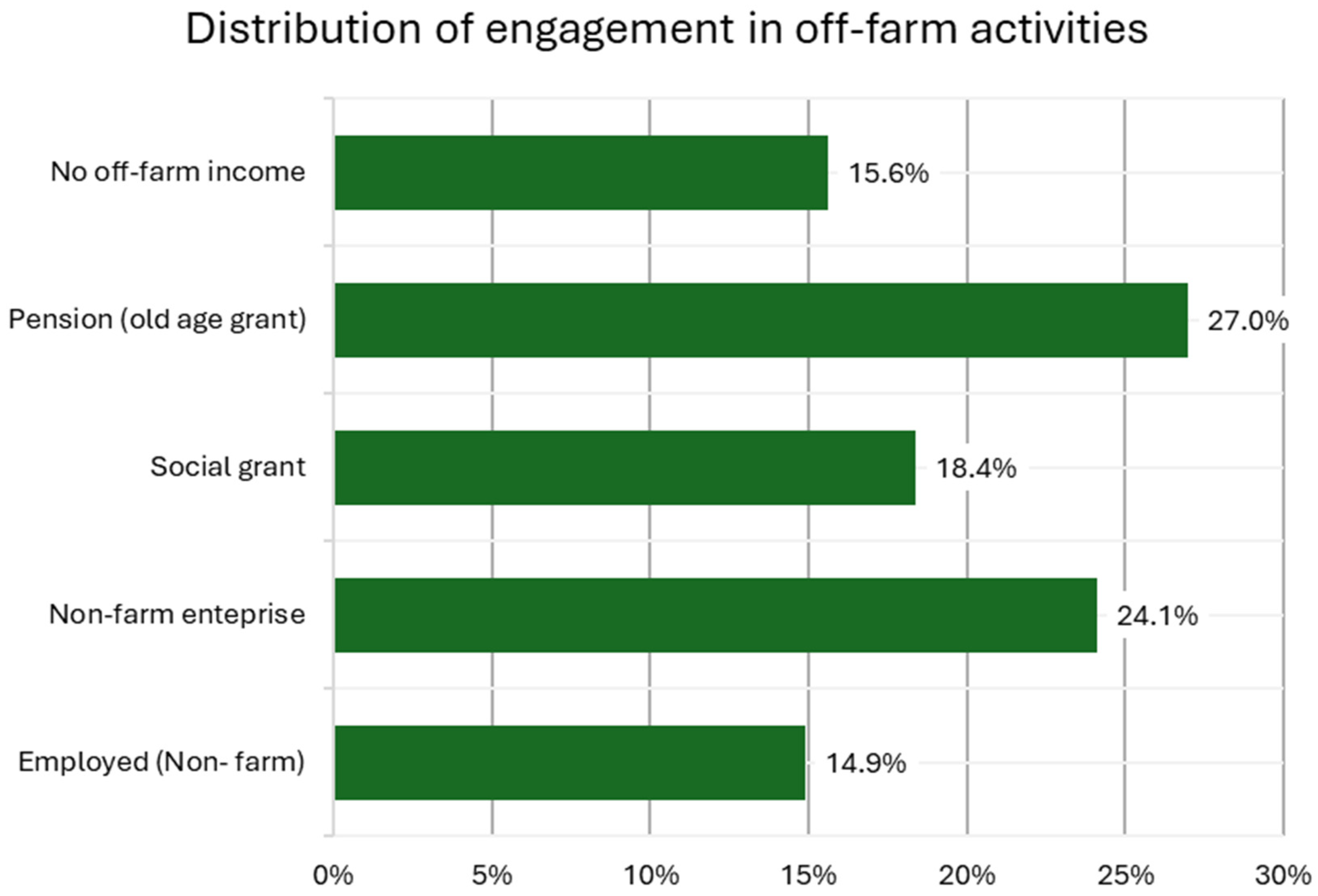
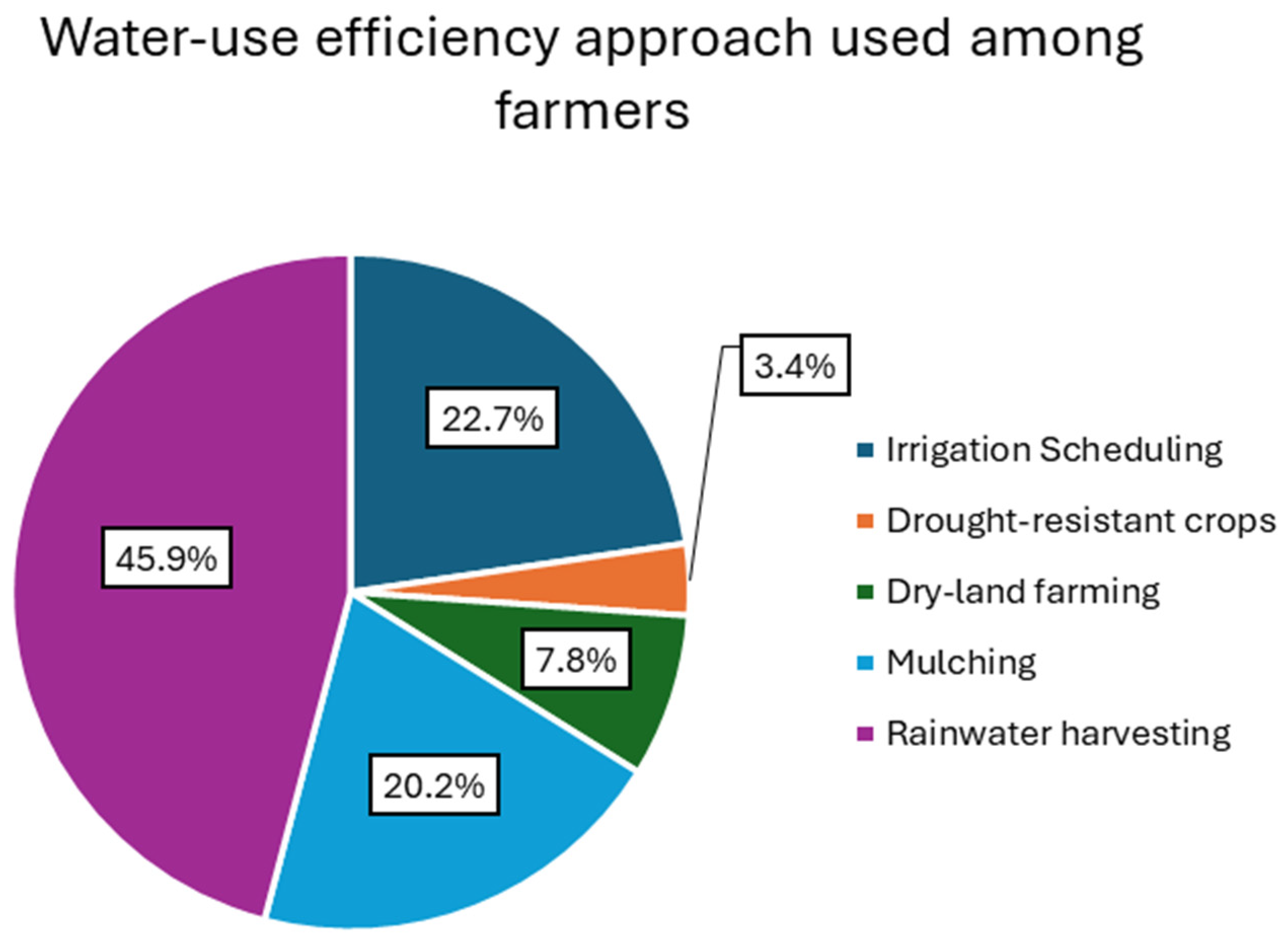
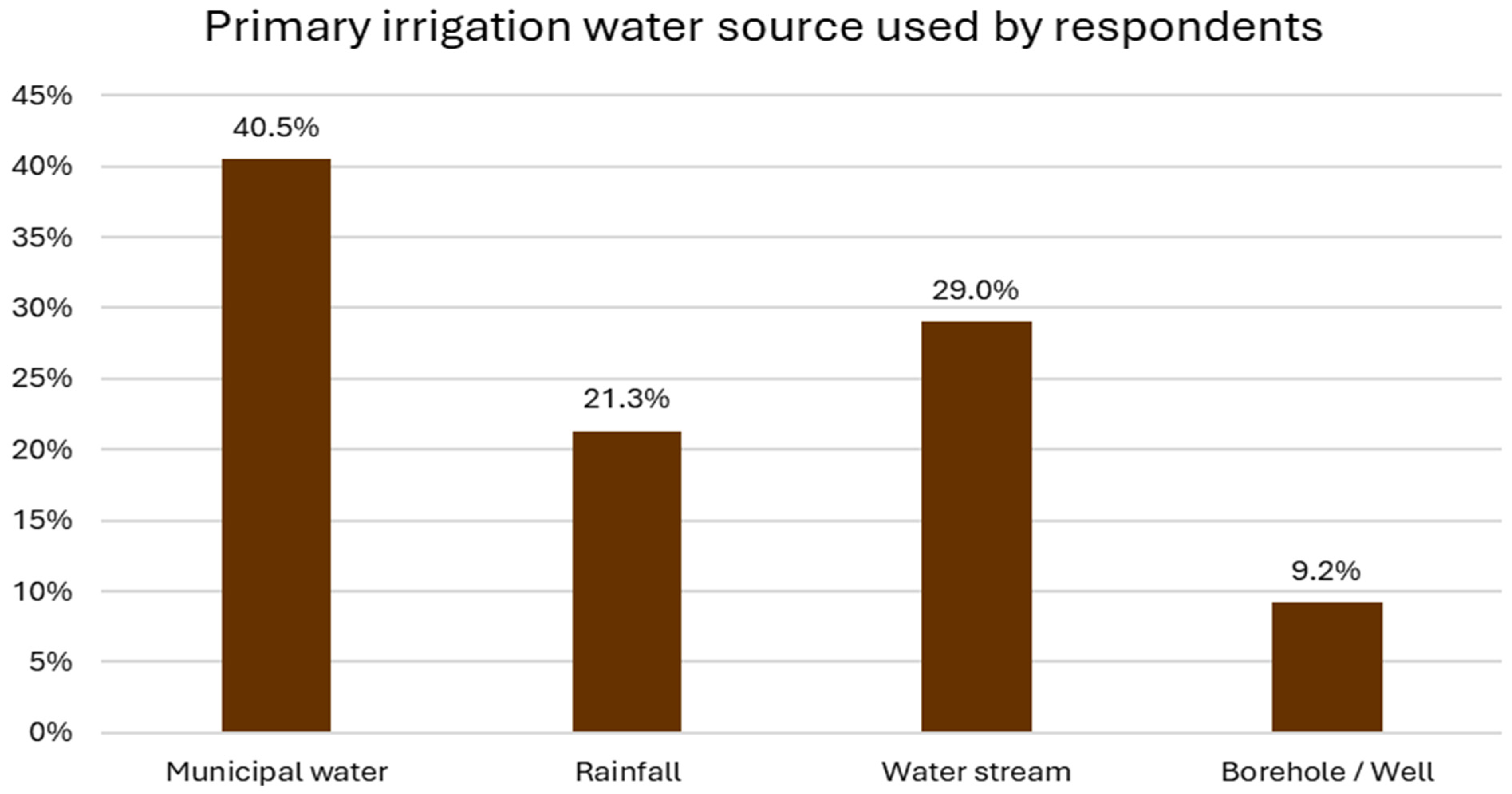
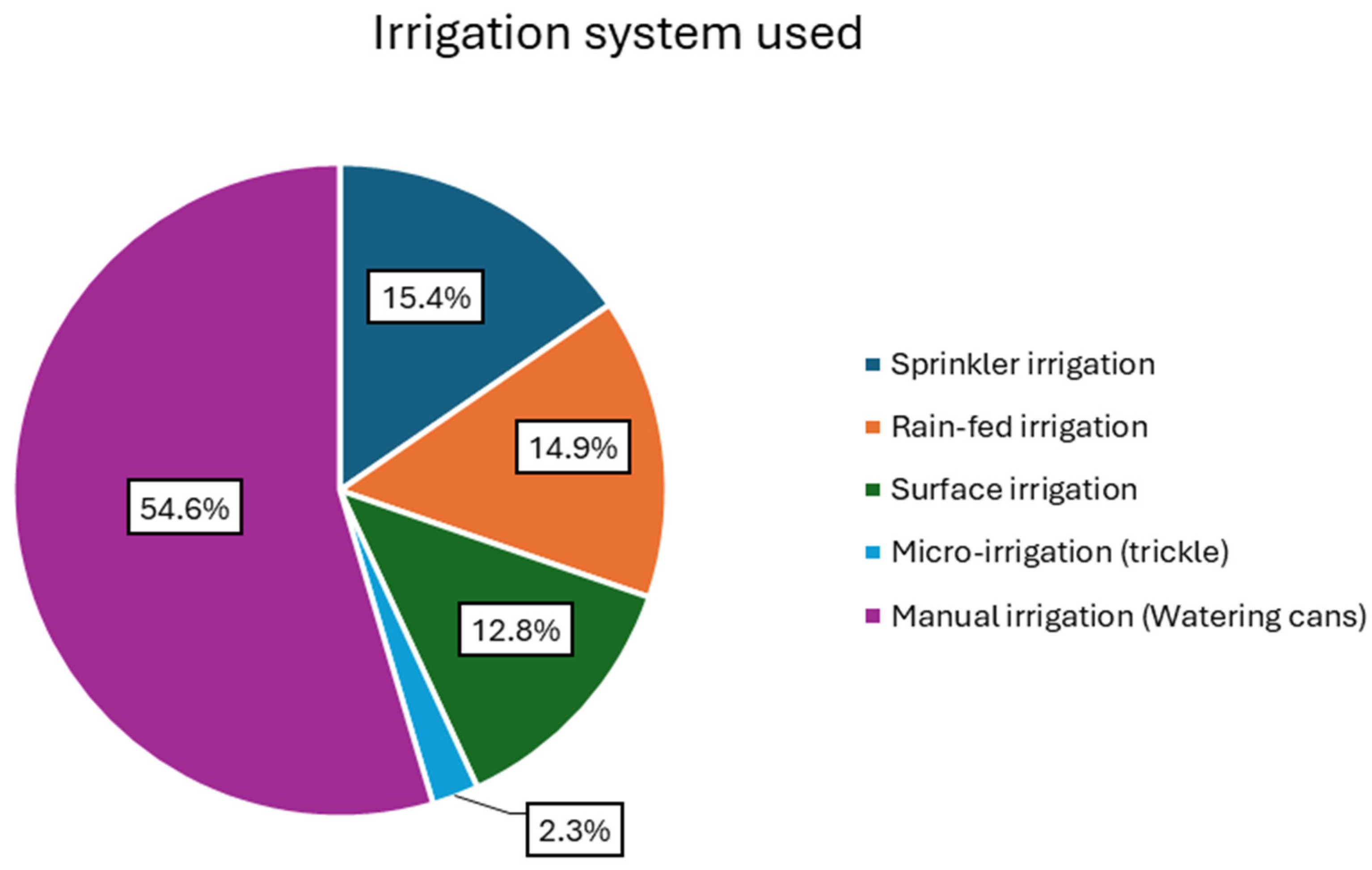
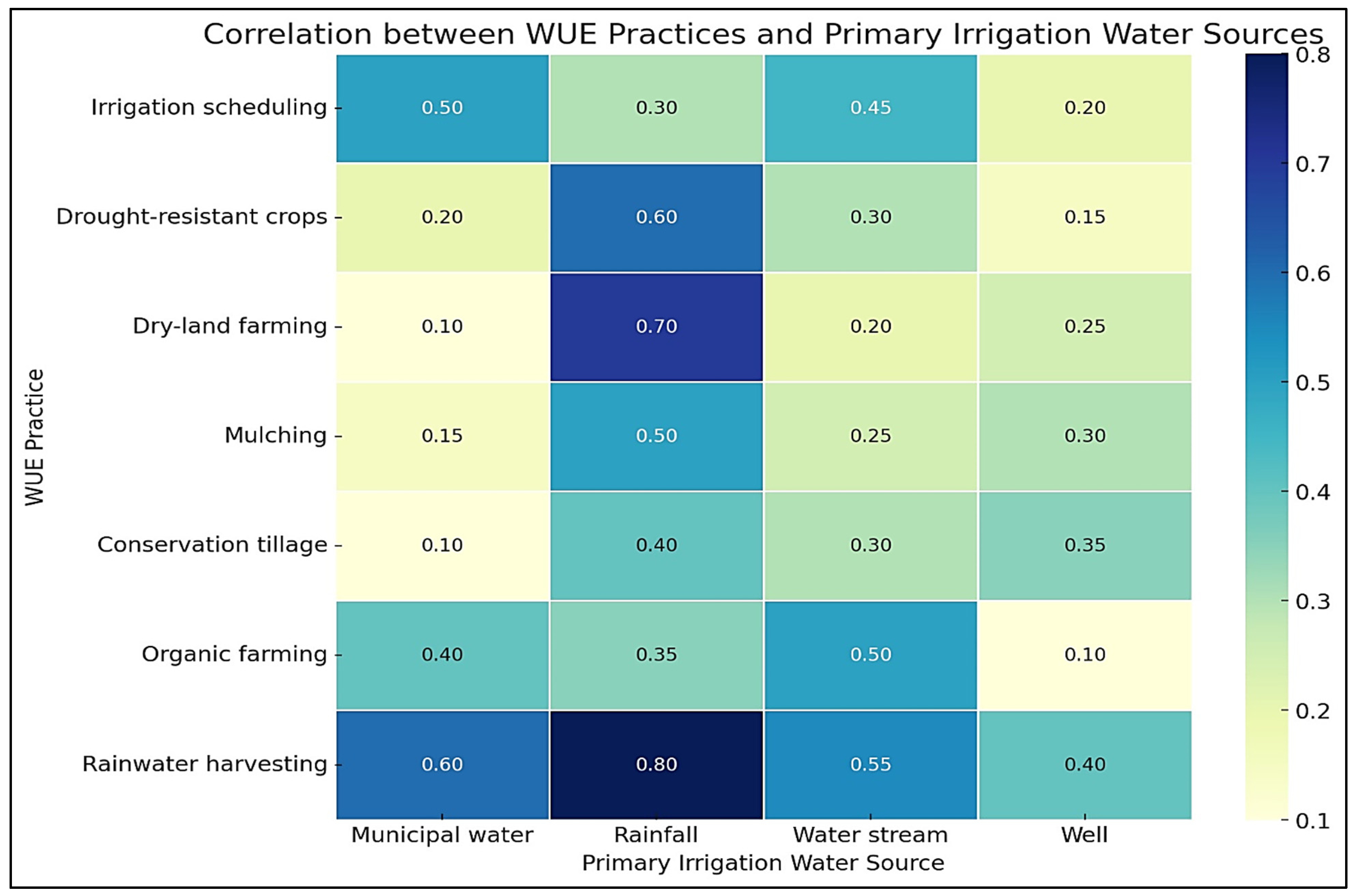
| Opinion | Value | Mean Interval |
|---|---|---|
| Strongly disagree | 1 | 1.00–1.80 |
| Rarely disagree | 2 | 1.81–2.60 |
| Disagree | 3 | 2.61–3.40 |
| Agree | 4 | 3.41–4.20 |
| Strongly agree | 5 | 4.21–5.00 |
| Challenges | N | Minimum | Maximum | Mean | Std. Deviation |
|---|---|---|---|---|---|
| I lack reliable water supply. | 141 | 1.00 | 5.00 | 3.60 | 1.00 |
| The soil on my farm has a poor water-holding capacity. | 141 | 1.00 | 5.00 | 3.78 | 0.85 |
| I do not have water efficient irrigation system (s). | 141 | 1.00 | 5.00 | 3.91 | 0.71 |
| I cannot irrigate as much as I would due to a lack of water storage system. | 141 | 1.00 | 5.00 | 3.85 | 0.93 |
| I do not have access to financial assistance. | 141 | 1.00 | 5.00 | 4.09 | 0.85 |
| My farm income is inconsistent seasonally due to unreliable market. | 141 | 1.00 | 5.00 | 3.96 | 0.91 |
| I do not have enough knowledge on irrigation water management. | 141 | 1.00 | 5.00 | 4.00 | 0.84 |
| Climate change effects such as droughts regularly affect my production output. | 141 | 1.00 | 5.00 | 3.89 | 0.90 |
| Primary Irrigation Water Source | Application of WUE Approaches | ||
|---|---|---|---|
| Primary irrigation water source | Pearson Correlation | 1 | 0.339 ** |
| Sig. (2-tailed) | 0.000 | ||
| N | 141 | 141 | |
| Application of WUE approaches | Pearson Correlation | 0.339 ** | 1 |
| Sig. (2-tailed) | 0.000 | ||
| N | 141 | 141 | |
Disclaimer/Publisher’s Note: The statements, opinions and data contained in all publications are solely those of the individual author(s) and contributor(s) and not of MDPI and/or the editor(s). MDPI and/or the editor(s) disclaim responsibility for any injury to people or property resulting from any ideas, methods, instructions or products referred to in the content. |
© 2024 by the authors. Licensee MDPI, Basel, Switzerland. This article is an open access article distributed under the terms and conditions of the Creative Commons Attribution (CC BY) license (https://creativecommons.org/licenses/by/4.0/).
Share and Cite
Morepje, M.T.; Agholor, I.A.; Sithole, M.Z.; Msweli, N.S.; Thabane, V.N.; Mgwenya, L.I. Examining the Barriers to Redesigning Smallholder Production Practices for Water-Use Efficiency in Numbi, Mbombela Local Municipality, South Africa. Water 2024, 16, 3221. https://doi.org/10.3390/w16223221
Morepje MT, Agholor IA, Sithole MZ, Msweli NS, Thabane VN, Mgwenya LI. Examining the Barriers to Redesigning Smallholder Production Practices for Water-Use Efficiency in Numbi, Mbombela Local Municipality, South Africa. Water. 2024; 16(22):3221. https://doi.org/10.3390/w16223221
Chicago/Turabian StyleMorepje, Mishal Trevor, Isaac Azikiwe Agholor, Moses Zakhele Sithole, Nomzamo Sharon Msweli, Variety Nkateko Thabane, and Lethu Inneth Mgwenya. 2024. "Examining the Barriers to Redesigning Smallholder Production Practices for Water-Use Efficiency in Numbi, Mbombela Local Municipality, South Africa" Water 16, no. 22: 3221. https://doi.org/10.3390/w16223221
APA StyleMorepje, M. T., Agholor, I. A., Sithole, M. Z., Msweli, N. S., Thabane, V. N., & Mgwenya, L. I. (2024). Examining the Barriers to Redesigning Smallholder Production Practices for Water-Use Efficiency in Numbi, Mbombela Local Municipality, South Africa. Water, 16(22), 3221. https://doi.org/10.3390/w16223221










